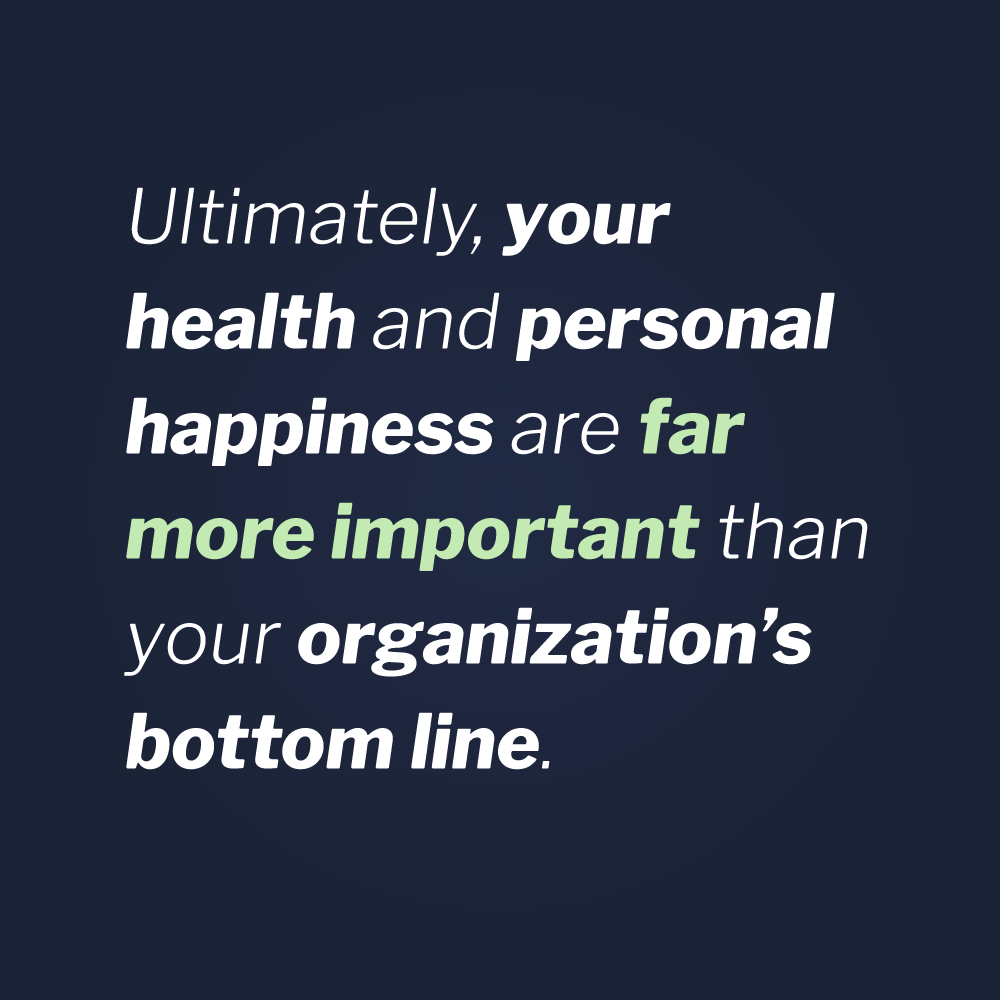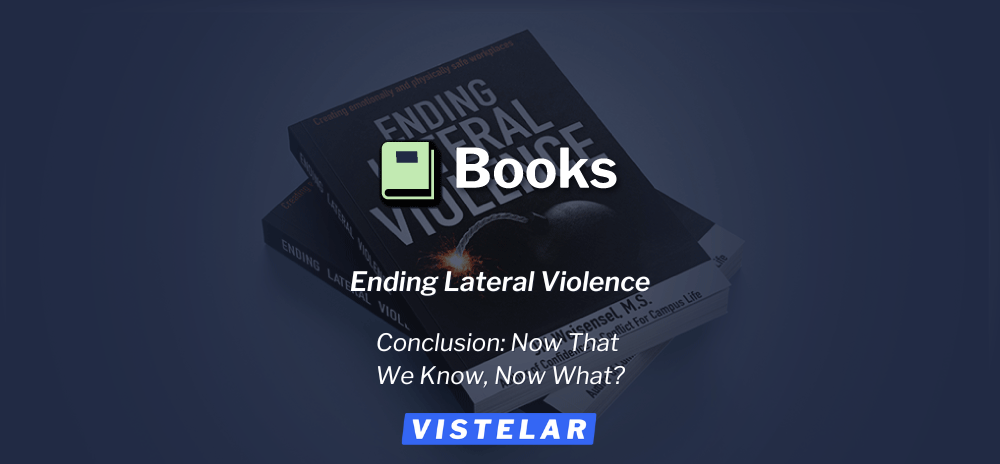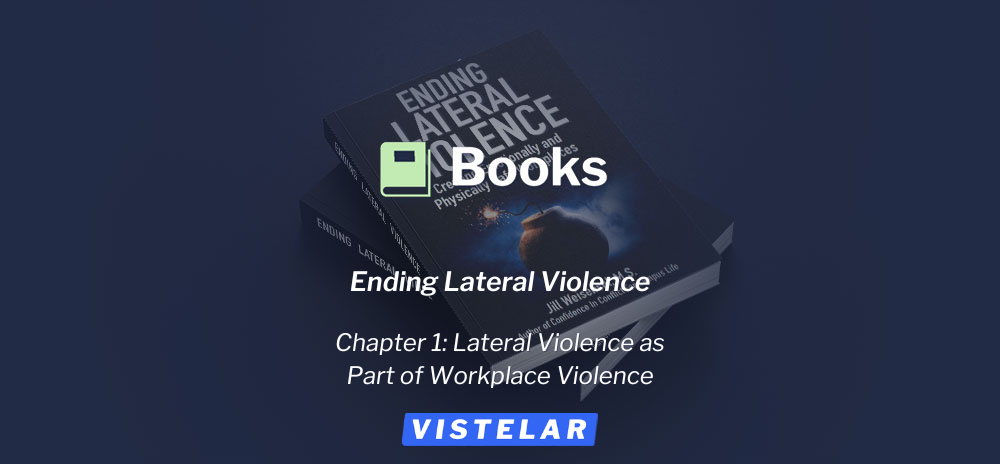Enjoy this excerpt from one of our published books.
Chapter 10
Conclusion: Now that we know...now what?
Throughout this book, you have learned that everyone plays a crucial role in creating a safe workplace—one that you can be proud to be a part of and in which you feel physically and emotionally safer. I sincerely hope you enjoyed this book, but more importantly, I hope you have learned some of the strategies and skills necessary to end lateral violence.
Whether you have perpetrated, condoned, ignored, or been victimized, you can make a difference.
“What we do today, right now, will have an accumulated effect on all of our tomorrows.”
– Alexandra Stoddard, philosopher and bestselling author of 28 books
Studies have shown that those who engage in lateral violence remember doing so. In one nursing study alone, upwards of 85.5% of participant nurses reported feeling “deeply sorry” for their actions. (Ayakdas & Arslantas, 2018)
With that being said, what can you do? What are some things to consider if you have found yourself engaging in these behaviors, perhaps because it’s all you’ve ever known? Even if you didn’t mean any harm, or if you weren’t aware that you engaged in behaviors that are harmful to others, it is probable that if you’ve made it to this part of the book, you’ve realized the damage caused by incivility and you’re willing to take ownership in improving.
Being aware of the behavior is the first step. Perhaps it has gotten back to you that other employees have complained about your behavior, comments you’ve made in meetings, facial expressions, or your attitude towards a particular person or topic. This alone serves as a data point and one to deeply reflect on.
Wait. What?
Yes, reflect on the feedback you’re getting. Seek out additional feedback from a trusted colleague, personal coach, or mentor. Seek out additional feedback and perspectives from 360 surveys, and don’t get defensive. Instead of shutting it down and dismissing the input from others, ask yourself, “How have I been acting that could have made them feel this way?” Ask, “What has happened to them?” Ask yourself these questions rather than assuming something is clearly “wrong with them.” You’ll never look good trying to make someone else look bad. Full stop.
Also, look inward to evaluate your behavior. Yes, self-work and internal work are hard. It is highly uncomfortable. So it will take both vulnerability and courage to move from behaving uncivilly to civilly. Identify the behaviors you want to change and write them down. Perhaps journal or keep a reminder card that lists the action you want to change and what to do about it. Then, make a conscious effort to do those things. This could be as simple as remembering to smile at work or using words like “please” and “thank you.” It could be as simple as being sincere in your gratitude or making a greater effort to listen.
Dedicated effort and small changes will lead to big results in behavior change.
“All this will not be finished in the first 100 days. Nor will it be finished in the first 1,000 days. Nor even perhaps in our lifetime on this planet. But let us begin.”
– John F. Kennedy
And what if you’ve now realized that you’ve been the target of these behaviors and that it is unacceptable?
First, do not fall into the trap of assuming that lateral violence is the same as schoolyard bullying. There are decades of research showing that “fighting back” (as you would, perhaps, on a schoolyard playground) is not effective. Researchers Christine Pearson and Christine Porath put it this way in their 2009 book, The Cost of Bad Behavior:
Workplace offenders have very little in common with schoolyard bullies. Two-thirds of workplace offenders have the power of the organizational hierarchy behind them; they call the shots on the corporate playing field. Although some high-power organizational offenders may seem at first to accept your pushback, you must not forget that they have resources, connections, and hierarchical perspectives that exceed your own. That would mean, in the playground analogy, that the principal and the teachers would be the bullies.
Do not sit idly by. Throughout the book, I’ve cited numerous reasons why long-term exposure to these behaviors is dangerous for your health, including that those exposed to lateral violence and workplace incivility over time are 35-55% more likely to be diagnosed with a major disease—such as cardiac problems, stroke, and diabetes— than those who have not been exposed. (Sull & Sull, 2022) Remember, doing nothing is never a neutral option.
So what can you do?
In addition to all of the low-level and point-of-impact intervention options presented in this book, I can offer a few more recommendations through my own observations, experiences, and collective understanding of both the research and best practices.
Resilience in the Face of Victimization
The first step is recognizing that you’ve been the target of this behavior, and it is going to take its toll on you. Regardless of how resilient you are and how “strong” you are, this type of behavior will impact you emotionally and physically. Surround yourself with a network of people who will support you and provide you with guidance you trust.
Then you have a decision to make, and that decision will depend completely on your specific circumstances and your level of comfort with the situation:
- You can try to minimize the amount of time you’re exposed to the offender.
- You can try to vary the types of interactions you have with the offender.
- You can try to work through the situation by speaking with the offender directly.
- You can choose to work through the situation by speaking with allies and creating your own internal support
- You can speak to someone of higher
There are many pros and cons and variables in each of these scenarios. For some people, minimizing the amount of time you’re exposed to the offender may be impossible, such as when this person is your direct supervisor. In this case, varying the types of interactions may be a possibility, such as communicating more via email or phone rather than face-to-face. Or, maybe you can coordinate that another supervisor is in the room whenever you need to have a critical conversation with that person.
Speaking with an ally is helpful when you have someone who knows both you and the offender. It is possible this person “has the ear” of the offender, in which case, the offender may be more open to suggestions from that person or more receptive to change.
Speaking to a person in authority is an option that requires trust and tact, but it can be done effectively. Remember to relay objective information—the facts of the situation. Focus on articulating the offender’s behaviors and how they make you feel. Describe how they are impacting your ability to most effectively do your job. Resist the urge to make it personal; this conversation should not be a bashing session describing all the reasons why you “don’t like” the person. If you are hesitant to have a conversation like this alone, consider bringing an ally, perhaps a co-worker who has witnessed the behavior and can help you relay what is happening while also being less emotionally invested. If the thought of having this conversation is intimidating for you, consider writing down your thoughts and key points on paper and have it with you when you start the conversation.
Finally, you can also reframe your thinking and change your approach to the situation. If the relationship between you and this person has become that of an immovable object meets an unstoppable force, resist the urge to distill your options down to a despondent “it’s either them or me, one of us will have to go” mentality. I’ve been in this situation and endured it for over nine years. I thought the end would never be in sight. It was suffocating. It was impossible to focus at work. It was impossible to sleep or eat.
At times, it had gotten so bad that I was certain I would have to trade in all that I had worked for just so I could survive. But then, one day, I realized the behaviors wouldn’t change, and I could do little more than address them as they came up, in front of peers. Soon other employees took notice and started standing up, calling out the behaviors and offering suggestions for improvement. Slowly, over time, things got a little better. Not great. But better. And then I realized I had made the decision to “take the high road.” Not the decision to “turn the other cheek” and ignore it, but to act at a higher moral and ethical level than that person was professionally able to.
Pearson and Porath (2006) note that people targeted by incivility have various rationales for reframing their thinking rather than seeking retribution. Some of these reasons are:
- Citing “cosmic justice,” the belief that people like that will eventually “do themselves in.”
- Feeling apathy toward the offender, thinking the person is not worth their “time” or “effort.”
- Viewing it as a job requirement, that they have to “work with the person” and they will continue to do their job, but perhaps not alone with that person.
- Believing that it’s bad timing, that they’ll take action eventually, but not now.
Finally, in organizations in which toxic corporate culture is well established and has free rein, reframing your thinking may also involve “withdrawing emotionally from your job.” (Pearson & Porath, 2006)
I cannot make this point better than Stanford Professor Dr. Robert Sutton. In his 2007 book The No Asshole Rule, he states:
All this talk about passion, commitment, and identification within an organization is absolutely correct if you are in a good job and are treated with dignity and respect. But it is hypocritical nonsense to the millions of people who are trapped in jobs and companies where they feel oppressed and humiliated …
If you’ve tried the options described above and nothing is improving the situation, perhaps look to see if a lateral transfer position is open and available before making a decision to quit.
Ultimately, your health and personal happiness are far more important than your organization’s bottom line.
“Leaders lead from the front. The most powerful leadership tool you have is your own personal example.”
– John Wooden, legendary American basketball coach
And finally, if you have the privilege of being an organizational leader, please do not underestimate the influence, power, and responsibility you have in creating systemic organizational change. Truly, you are in the best position to have an impact during every touchpoint of the organizational change process: from the planning and preparation - all the way through the implementation, management, and maintenance of change.
I would be hard-pressed to identify a more rewarding experience or accomplishment for a transformational leader than being able to state that you were on the front line of true organizational change—a change that reduced workplace toxicity, improved organizational culture and productivity, and one that will help your employees not only survive, but thrive.
“We carry with us, as human beings, not just the capacity to be kind but the very choice of kindness. You see, the way we react to a situation is a true test of character. Never forget that.”
– Brent Lindeque, motivational speaker and change agent
Key Takeaways
- Whether you have perpetrated, condoned, ignored, or fallen victim to lateral violence, you have a crucial role to play in creating an emotionally, psychologically, and physically safe workplace environment.
- Self-reflect and ensure that you are not part of the problem. And if you are, make a commitment to change your behavior.
- If you have been the target of lateral violence, do not sit idly by. Seek out an ally, solicit feedback, and determine the best course of action depending on your specific circumstances.
- If you are an organizational leader and in a position of authority, take action to create organizational change.









